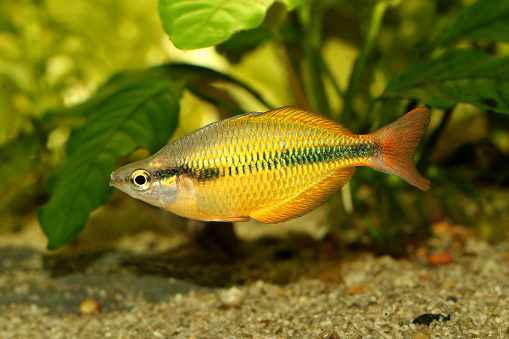ANIMAL: Lake Tebera Rainbowfish Melanotaenia herbertaxelrodi Type of Animal: Rainbowfish Habitat: Lake basins, lakes, streams, clear tributaries surrounding clear lakes w/ abundant aquatic vegetation, lake shoreline margins in tall grasses/subsurface vegetation Location(s): Lake Tebera basin in C New Guinea Appearance: Big eyes, forked mouth, males bright yellow (sometimes w/ greenish tinge) w/ blue-black mid-lateral line & longer dorsal/anal fins, fins redder/more colorful in breeding season, males also deeper bodied than females w/ high forehead & angulated breast profile, females drabber w/ more silvery-yellow coloration, younger fish more silvery, become more colorful w/ age, tail wide rather than long Food/Diet: Ants, beetles/beetle-like insects, insect larvae, fruit flies, brine shrimp, fruit, algae, bloodworms, daphnia, microworms, earthworms, aquatic vegetables Status in Wild: Unknown Conservation: Breeding in aquariums, zoos, & aquaculture Lifestyle: Schools of 6-30 w/ more females than males Additional Info: Called: Male Female Young: Fry Group: School Gestation: 7-12 days Life Span: 3-5 years Body Length: Male: 4-5 in Female: 3-4 in Young: 0.7 in Tail Width: Male: 1.5 in Female: 1.25 in Also called Yellow Rainbowfish, Lake Tebera Yellow Rainbowfish, Herbert Axelrod’s Rainbowfish, Axelrodi Rainbowfish, & Axelrod’s Rainbowfish. Specific name herbertaxelrodi honors Herbert Axelrod (founder of Tropical Fish Hobbyist magazine in 1952) who died in 2017. Conservation status unknown but potential threats are water pollution, habitat degradation, pet trade, overfishing, & restricted range. Spawning can last weeks, sometimes months, w/ females laying multiple egg batches (usually 20-30 eggs total) per day. Fry spend much of their time very close to the surface. Like other rainbowfish, they’re very active swimmers. Females scatter eggs on vegetation. Females more attracted to more colorful/brighter males & male competition/displaying often results in better breeding. They’re active hunters capturing prey instant it hits water. Juveniles become mature at 9 months old. Dorsal/ventral fins lend stability in swimming while tail/caudal fin helps it propel through water. Pectoral fins for locomotion & side to side movement. Fun Fact(s): These fish secrete mucus through skin providing protection against infections/parasites. They’re now widely captive bred. These fish fairly common in aquarium trade. When spooked/startled, they will jump. 1st introduced to aquarium hobby in 1980 in Australia, then being distributed worldwide.
